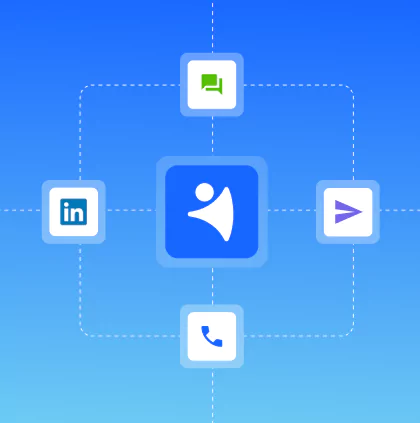Ready to sell like today’s top AEs? Start here.
Top-performing Account Executives don’t "ask for the sale" — they ask the right questions. The kinds that reveal real objections, inspire confidence, and help the buyer take the next step with clarity.
Here are 25 questions + bonus tips to close deals with confidence.
#1: Unlock the decision-making web
Unfortunately, a few deals are solo decisions today. Most deals today involve 6–8 decision-makers, which means you’re selling to the entire decision-making network. To earn their trust, you’ll have to do some research first.
Dig through the company’s LinkedIn account, website, social media, and other sources to identify key players and understand their influence, objections, and timeline.
Here are also a few questions that can help uncover the internal decision-making process if your research doesn’t end in success.
- “What’s your leadership team most concerned about when approving deals like this?” This question targets the behind-the-scenes decision logic and helps you understand the internal politics and hidden criteria.
- “Has legal/procurement already seen the contract?” Asking early about internal approvals keeps deals from getting stuck at the finish line.
- “Who else needs to be involved in the final decision?” It’s a classic stakeholder check that reduces the risk of late-stage blockers and helps you identify the key decision makers.
- “What would need to happen for you to feel 100% ready to commit?” This is a powerful way to uncover the last missing piece and guide the final conversation with focus.
- “If the decision were solely yours, would we be moving forward today?” This separates buyer intent from organizational politics, and highlights hidden stakeholders. It’s also a good question if you’re too shy to ask directly who the decision-makers are.
?️ Bonus tip: Look for team members commenting on product posts — they’re often involved but not listed in org charts.

Alex Kasianenko
Account Executive, NetHunt CRM“My favorite question during this stage is “What would need to be in place internally for your team to fully adopt NetHunt within the first 30 days?” This uncovers internal blockers (data migration, process mapping, etc.), subtly assumes the close, and opens the door to talk about our onboarding support - a NetHunt strength.”
#2: Discover hidden objections
You might have encountered that buyer type: too polite to object, doesn’t want to offend you, and doesn’t know how to express their concerns with clarity.
To close the deal, you need to know the potential roadblocks and address concerns in time.
So, here are a few subtle around-the-edge questions that might help.
- “What were you thinking about while I was showing you this feature?” Helps you add more information and target objections in time.
- “If this solution were free, would you implement it tomorrow?” Sometimes, leads are very lackadaisical to show their objection if it’s not related to budget concerns. This question helps you take the cost off the table to isolate the real objection.
- “How would you rate this demo on a scale from 1 to 10?” If they’ve got more concerns and questions, you can offer a quick follow-up.
- “What part of this deal feels like a leap of faith right now?” This question creates space for dialogue and uncovers the barriers that are difficult to see at first sight.
- “Is there anything giving you pause about this solution?” It’s a low-pressure way to ask about doubts, and makes it safe for the buyer to be honest.
?️ Bonus tip: Try to reframe objections as questions. Ask, “What question is still unanswered for you?” People respond better to this than “What’s your objection?” or “What is the thing you don’t like about our solution?”
#3: Connect on a human level
Too many sales conversations get lost in features, metrics, and timelines. But emotions, intuition, and team dynamics play a huge role in closing.
Here is how to tap into the human side of the deal.
- “What would your team say if you told them we weren’t moving forward?” This question helps you check the internal alignment and the urgency of adopting your solution.
- “Who would be the first person on your team to benefit from our solution?” Makes the solution feel real, immediate, and people-centered. It’s a great way to bridge the gap between logic and emotion, showing that getting your solution isn’t only about numbers but also people.
- “What’s your gut telling you?” This question is a great way to build honesty and cut through analysis paralysis.
- “What’s the story you’ll tell if this decision turns out to be a win?” This reframes the choice as a future success story, tied to the buyer’s personal win.
- “What kind of partner are you looking for beyond the purchase?” Opens the door to values, expectations, and relationship building.
?️ Bonus tip: Mirror buyer’s emotions. If the buyer expresses excitement, match it. If they’re cautious, don’t push. Instead, show empathy and confidence.
#4: Show tangible impact
Tie your solution to results that matter: your lead wants to see how your solution would impact their metrics, goals, and roadmap.
These questions help the buyer connect the dots between your product and real-world outcomes they care about.
- “If we fast-forwarded to the end of this quarter, what would you hope to have accomplished with us?” It shows the immediate impact of your solution once they implement it.
- “What would make this a no-brainer for you?” This invites them to voice their ideal outcome and helps you persuade them that such an outcome is possible.
- “How does this compare to other priorities you’re juggling?” This helps you understand how high your solution ranks and reposition the value if needed.
- “How would this solution affect your top KPIs?” Making the connection to performance metrics helps justify the purchase internally.
- “If your CEO asked why you chose this solution, what would you say?” This question elevates the narrative from features to impact and helps craft internal justification.
?️ Bonus tip: Show, don’t tell. Showcase your customer a few case studies where your solution helped companies overcome similar challenges.

Alex Kasianenko
Account Executive, NetHunt CRM“One question I like to ask here is “Let’s say you rolled this out. What would success look like 90 days from now in your pipeline or reporting?” This helps buyers visualize tangible CRM impact — cleaner pipeline, better activity tracking, more confident forecasting. It also positions us as a partner in outcomes, not just software.”
#5: Drive momentum with next-step thinking
Once you’ve cleared lead’s objections and shown value, shift the conversation into forward motion with maximum clarity.
Here are a few questions to create a shared plan, set expectations, and reduce post-call ambiguity.
- “What would make you feel truly supported after the signature?” Such a question positions you as a partner through implementation and beyond and offers a sense of long-term security.
- “If you decided to move forward today, what’s the first thing we should do together?” A pretty bold question that assumes the close in a customer-first way.
- “What are the key milestones between now and launch?” This helps both sides map out next steps and timelines collaboratively.
- “If we move forward this week, when could we start implementation?” This question acts as a subtle push toward commitment. It’s an assumptive close but framed as a practical planning step.
- “Is there a date you're targeting internally to wrap this up?” The question gently invites the buyer to reveal their internal timeline, without pressure.
?️ Bonus tip: Visualize the customer buying journey. End the call by opening up a shared timeline or Miro board to visually map the path forward.

Alex Kasianenko
Account Executive, NetHunt CRM“My favorite closing question is “If your team started using NetHunt tomorrow, what’s the first workflow you’d want to automate?” Why? Because this gets the buyer thinking practically about how NetHunt fits into their day-to-day and reminds them of the daunting manual processes that our tool solves.” ”
Final thoughts
In B2B sales, the final 10% of the journey often determines 100% of the outcome. That’s why it’s so important to approach the close with intention and curiosity without being too pushy.
These questions help you close a deal faster, build trust, and create alignment for the future steps. The best advice? Lead with empathy and clarity to make a closing feel like a natural outcome of conversation.
You’ve got it!
FAQ
What are the best closing questions?
The best closing questions aren’t pushy. They sound natural & buyer-focused and help you uncover timelines, priorities, and hidden concerns. Examples include:
- “What needs to happen for you to feel 100% confident moving forward?”
- “Who else needs to weigh in before we make this official?”
- “What would success look like six months from now if we partnered up?”
What makes a good closing question?
A good closing question does three key things:
- Moves the deal closer to a decision;
- Reveals the buyer’s real thoughts, concerns, or blockers;
- Encourages alignment and shared next steps.
How do I ask about the timeline without sounding pushy?
Instead of asking, “Can we close this by Friday?”, focus on the lead's goals. Try these collaborative alternatives:
- “Is there a timeline you’re working toward internally?”
- “What’s your ideal launch or rollout date?”
- “When would it be most helpful for your team to have this in place?”




















 product experts — let's find the best setup for your team
product experts — let's find the best setup for your team